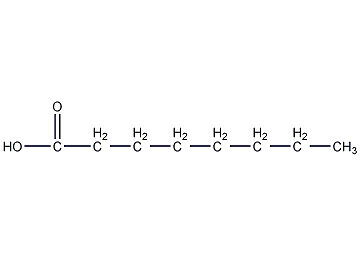
Structural formula
| Business number | 03HQ |
|---|---|
| Molecular formula | C8H16O2 |
| Molecular weight | 144.21 |
| label |
n-octanoic acid, Caprylic acid, Capric triglyceride, caprylic acid, Octanic acid, n-Octanoic acid, pesticides, antifungal agent, Rust inhibitor, corrosion inhibitor, foaming agent, Defoaming agent, plasticizer, acidic solvent |
Numbering system
CAS number:124-07-2
MDL number:MFCD00004429
EINECS number:204-677-5
RTECS number:RH0175000
BRN number:1747180
PubChem number:24901335
Physical property data
1. Properties: Colorless and transparent liquid with a sweaty odor.
2. Boiling point (ºC, 101.3kPa): 239.7
3. Melting point (ºC): 16.5
4. Relative density (g/mL, 20 /4ºC): 0.9073
5. Relative density (g/mL, 25/4ºC): 0.9066
6. Relative vapor density (g/mL, air=1): 5
7. Refractive index (n20ºC): 1.4280
8. Refractive index (n25ºC): 1.4261
9. Viscosity (mPa·s,20ºC): 5.828
10. Viscosity (mPa·s, 30ºC): 4.690
11. Flash point (ºC): >110
12. Heat of evaporation (KJ /mol, 134ºC): 70.05
13. Heat of evaporation (KJ/mol, b.p.): 58.49
14. Heat of fusion (KJ/mol): 21.39
15. Specific heat capacity (KJ/(kg·K), 16~36ºC, constant pressure): 2.15
16. Electrical conductivity (S/m, 80ºC): 3.7×10-3
17. Vapor pressure (kPa, 92ºC): 0.13
18. Dissociation constant (25ºC, water): 1.27×10-5
19. Solubility: Soluble in organic solvents such as ether, chloroform, carbon disulfide, petroleum ether, glacial acetic acid, and ethyl acetate. It dissolves 0.068g in 100g water at 20℃ and 0.113g at 60℃. Water dissolves 3.88% in octanoic acid at 14.4°C. Dissolve 770g in 100g benzene at 10℃. It dissolves 262g in 100g ethanol at 0℃ and 1035g at 10℃. Dissolve 280g in 100g isopropyl alcohol at 0℃ and 990g at 10℃.
20. Critical temperature (ºC): 419.85
21. Critical pressure (MPa): 2.87
22. Critical density (g·cm-3): 0.278
23. Critical volume (cm3·mol-1): 519
24. Critical compression factor: 0.259
25. Eccentricity factor: 0.779
26. Solubility parameter (J·cm-3)0.5:22.324
27. van der Waals area (cm2·mol-1): 1.328×1010
28. van der Waals volume (cm3·mol– 1): 94.790
29. Gas phase standard combustion heat (enthalpy) (kJ·mol-1): -4880.4
30. Gas phase standard claimed heat (enthalpy) (kJ·mol-1): -554.2
31. Liquid phase standard heat of combustion (enthalpy) (kJ·mol-1 ): -4798.7
32. The liquid phase standard claims heat (enthalpy) (kJ·mol-1): -636.0
33 . Liquid phase standard hot melt (J·mol-1·K-1): 332.4
Toxicological data
1. Skin/eye irritation: rabbit eye standard Drez eye dye test: 500mg/24H has a moderate irritating effect on the eyes
2. Acute toxicity: rat oral LD50: 10080mg /kg; intravenous injection of mouse LC50: 600mg/kg
Rabbit skin LD50: >5gm/kg
3. Mutagenicity: Saccharomyces cerevisiae sex chromosome deletion and non-disjunction test system :5ppm
Ecological data
Molecular structure data
1. Molar refractive index: 40.67
2. Molar volume (cm3/mol): 155.2
3. Isotonic specific volume (90.2K ): 372.2
4. Surface tension (dyne/cm): 33.0
5. Polarizability (10-24cm3): 16.12
Compute chemical data
1. Reference value for hydrophobic parameter calculation (XlogP): None
2. Number of hydrogen bond donors: 1
3. Number of hydrogen bond acceptors: 2
4. Number of rotatable chemical bonds: 6
5. Number of tautomers: none
6. Topological molecule polar surface area 37.3
7. Number of heavy atoms: 10
8. Surface charge: 0
9. Complexity: 89.3
10. Number of isotope atoms: 0
11. Determine the number of atomic stereocenters: 0
12. Uncertain number of atomic stereocenters: 0
13. Determine the number of chemical bond stereocenters: 0
14. Number of uncertain chemical bond stereocenters: 0
15. Number of covalent bond units: 1
Properties and stability
1. Basic properties: It exists in coconut oil, lemon leaf oil and lanolin in the form of ester. It exists in free form in plant essential oils such as Tibetan cypress (Cupressus tolurosa), Japanese cedar (Cryptomeria japonica), tobacco, and nutmeg.
It is a colorless oily liquid at room temperature, slightly soluble in water, soluble in ethanol and ether.
2. Exist in flue-cured tobacco leaves, burley tobacco leaves, oriental tobacco leaves, and mainstream smoke.
3. Naturally found in apples and wheat bread.
Storage method
It should be placed in a cool and ventilated place away from fire sources.
Synthesis method
Brief description of production method: Industrial production of octanoic acid uses octanal as raw material. During laboratory preparation, n-hexylmalonic acid is used to heat to release carbon dioxide, and the pressure is reduced to 4-6.65kPa to complete the reaction. Finally, the reaction product is distilled under reduced pressure, and the 127-129°C (2.13kPa) fraction is collected as octanoic acid. The yield is 80-85%. Caprylic acid can be produced from the reaction of 1-octene and peracetic acid. In addition, there is oxidative dehydrogenation of n-octanol.
Refining method: use molecular sieves to dehydrate and then fractionate under reduced pressure. It can also be refined by fractional crystallization.
1. Octanal oxidation method
2. n-hexylmalonic acid method![]()
3. Oxidative dehydrogenation of n-octanol
4.1-Octene It is prepared by the reaction of 1-octene and peracetic acid:
5. Tobacco: OR, 44; OR, 49; BU, 56; OR, 26; FC, 9, 18; BU, 18; OR, 18; BU, 26; FC ,40. Synthesis: Obtained from saponification of coconut oil and then acidification and fractionation.
Purpose
1. Used in the manufacture of dyes, drugs, spices, etc., this product is an edible spice allowed in GB 2760-86. It is also used as plasticizer, lubricant, insecticide, antifungal agent, antirust agent, corrosion inhibitor, foaming agent, defoaming agent, etc., and is also used in ore separation.
2.Can be used for O/W and W/ O-type creams, O/W-type lotions, skin oils and bath oils, and lipid-rich Capsule body wash, shampoo, lipstick and other stick products as well as lotions and aerosol products with high alcohol content. The usage amount is as follows:
The dosage in O/W or W/O type paste, the dosage in emulsion and non-aqueous ointment is 5%~40%.
The dosage in skin oil or bath oil is 10%~60%.
The dosage of fat-rich capsule bath liquid or shampoo is 3%~20%.
The dosage in rod-shaped products is 10%~40%.
3. Commonly used in baked goods, meat products, and fast food.
The dosage is 10%~60%.
The dosage of fat-rich capsule bath liquid or shampoo is 3%~20%.
The dosage in rod-shaped products is 10%~40%.
3. Commonly used in baked goods, meat products, and fast food.



 微信扫一扫打赏
微信扫一扫打赏
